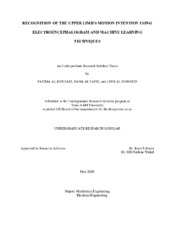| dc.description.abstract | The electroencephalogram (EEG) signals are a measurable brain electrical activity. EEG signals can be used to detect and classify motion intention of any voluntary action. Successful detection of EEG signals and classification of motion intention is crucial in Brain-Computer Interface (BCI) applications. BCI can be used for upper limb rehabilitation through the use of prosthetics or exoskeletons. In this project, a method is proposed to distinguish three motions, including moving an arm forward, grabbing an object, and moving an arm upwards as well as the rest position, a total of 4 different tasks. The data is collected using ENOBIO 8 system with seven electrodes. Four time-domain features extracted from the data include the mean absolute value, zero crossing, waveform length, and slope sign change. The k-Nearest Neighbor (k-NN) algorithm is used to classify the four classes. This study investigates various window sizes and different numbers of neighbors to achieve a higher classification accuracy. Using a grid search approach, it was determined that a window size of 1500 ms and a number of neighbors of produced the highest classification accuracy. The classification accuracy was 85.6 ±2.38%, while previous studies were only able to achieve classification accuracies between 60% and 78%. This result proves that varying the window size and the number of neighbors profoundly influence classification accuracy of motion intention; therefore, improving rehabilitation techniques for people with minimal arm movement and muscular dystrophy. The classified signals can be used for further biomedical research and be utilized to expand the growing biomedical research field in Qatar that relates to Brain-Computer Interface (BCI) technology. | en |


